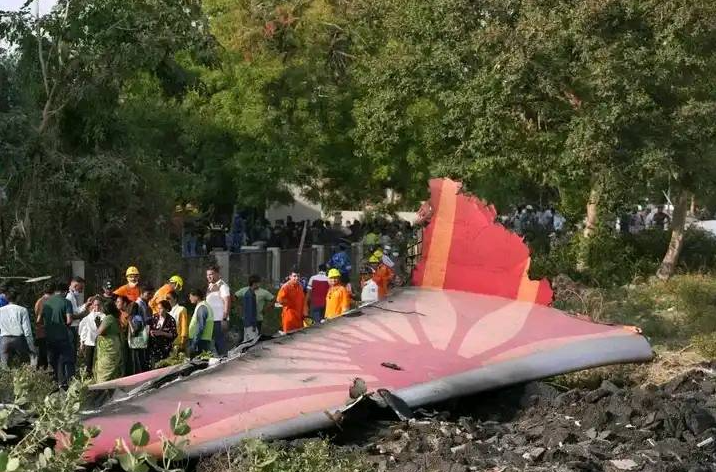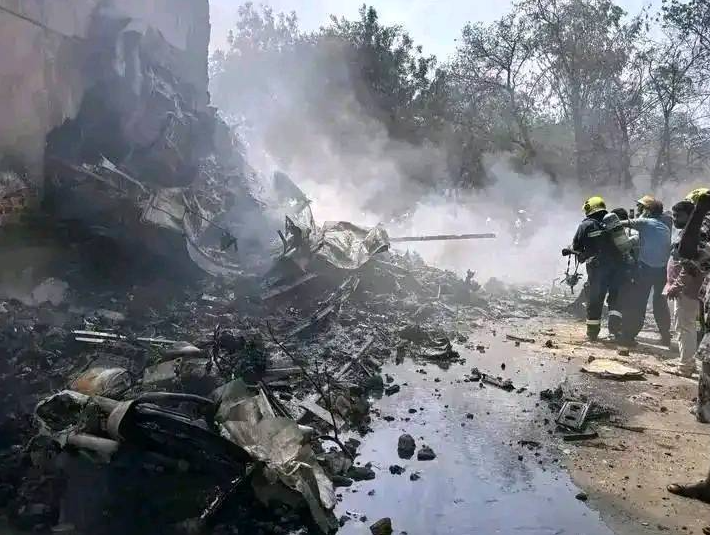
On June 12, 2025, tragedy struck the skies over Ahmedabad, India. Air India Flight AI 171, a Boeing 787-8 Dreamliner bound for London Gatwick, crashed shortly after takeoff from Sardar Vallabhbhai Patel International Airport. The aircraft collided with a student hostel building of B.J. Medical College, resulting in the deaths of 241 people onboard and at least 38 on the ground. It is one of the deadliest aviation disasters in India’s recent history.
This post explores the events leading to the crash, the heroic actions of the flight crew, the sole survivor’s story, the investigation, and the path forward for aviation safety.
🕰 Timeline of the Tragedy
- 13:38 IST: Air India Flight AI 171 took off with 230 passengers and 12 crew members.
- 13:38:45 IST: Within 50 seconds, the pilot issued a Mayday call, citing an unspecified emergency.
- 13:39 IST: The aircraft crashed into the B.J. Medical College hostel building in Meghaninagar, bursting into flames and causing structural collapse.
June 13-14, 2025: Black boxes (Flight Data Recorder and Cockpit Voice Recorder) were recovered for analysis.
👨✈️ The Flight Crew: Pilots Turned Heroes
Captain Sumeet Sabharwal
The 56-year-old pilot, with over 8,200 hours of flight experience, has been hailed as a hero. He remained calm under pressure, issued a Mayday, and reportedly tried to steer the aircraft away from a denser residential zone, minimizing potential ground fatalities.
First Officer Clive Kunder
With approximately 1,100 hours of flight experience, First Officer Kunder was assisting during the climb phase when the incident occurred. Both crew members lost their lives trying to save others.

🧍♂️ Sole Survivor: A Story of Miraculous Escape
Out of the 242 people onboard, only one survived — 28-year-old British national of Indian origin, Vishwash Kumar Ramesh. He managed to escape by leaping out of an emergency exit as the plane was breaking apart. Treated at a local hospital, he remains in stable condition and has become a symbol of hope in the midst of sorrow.
🧑🚒 Rescue and Recovery Operations
Emergency services rushed to the site within minutes. The hostel was engulfed in flames, with debris scattered over a 300-meter radius. Medical students, residents, and hospital staff joined hands with firefighters and NDRF teams to pull out survivors from the rubble.
Students posted real-time footage on social media showing the chaos: smoke, fireballs, collapsing ceilings, and cries for help. Many described narrowly escaping death as walls crumbled around them.
🔍 What Caused the Crash? The Investigation
Investigating Bodies
Air India’s Aircraft Accident Investigation Bureau (AAIB) is leading the probe. Support has come from the U.S. National Transportation Safety Board (NTSB), the UK Civil Aviation Authority (CAA), Canada’s Transportation Safety Board (TSB), and the Federal Aviation Administration (FAA).
Key Focus Areas
- Black Box Data: Initial analysis indicates the aircraft’s emergency power unit was activated shortly after takeoff, possibly indicating engine failure.
- Landing Gear & Flaps: The aircraft had not retracted its landing gear, and flap configurations appeared inconsistent with standard takeoff.
- Mechanical Fault: Investigators are probing whether a hydraulic or engine system failure occurred, causing sudden loss of control.
Human Factors: Air India was ordered to provide detailed training records of the pilots and the dispatcher to verify adherence to protocols.
🏢 Damage on the Ground
The aircraft crashed into the B.J. Medical College boys’ hostel, a five-story structure housing over 200 students. Several were trapped under debris. Rescue teams reported that parts of the plane’s fuselage had embedded deep into the building.
38 people on the ground were confirmed dead, and more than 50 injured, many critically. The government has promised a new facility and compensation for the affected students and their families.
🛫 Air India and Government Response
Air India
- Immediately grounded eight international flights.
- Conducted inspections on nine of its 33 Dreamliners.
- Set up emergency family assistance centers in Ahmedabad, Mumbai, Delhi, and London Gatwick.
- Provided an initial compensation of ₹1 crore (£85,000) for each deceased passenger’s family, with an interim relief of ₹25 lakh (£21,000).
DGCA (Directorate General of Civil Aviation)
- Ordered emergency drills at all major airports by June 30, 2025.
Mandated fleet-wide inspections of all Boeing 787-8 aircraft.
📉 Global Implications for Aviation
This was the first fatal crash involving a Boeing 787 Dreamliner, a model that entered commercial service in 2011 and had previously maintained a strong safety record.
Aviation experts warn that takeoff and initial climb phases remain the riskiest moments in any flight. The AI 171 crash has highlighted the importance of real-time diagnostics, emergency readiness, and better pilot training.
Industry-wide changes are expected, including:
- Revisions to training protocols.
- Enhanced monitoring systems during takeoff.
Stricter engine inspection requirements.
🕯️ Remembering the Victims
Memorials have been held in cities across India and the UK. Family members have begun the painful process of identifying remains, with more than 135 victims requiring DNA testing due to the severity of the crash.
The funeral of Captain Sumeet Sabharwal in Mumbai was attended by thousands, including airline colleagues and dignitaries. He is remembered as a professional who gave his life trying to save others.
🔧 What’s Next?
Final Report
A preliminary report is expected within 30 days, with a full accident report due in the next 3–6 months. This will include findings from the flight data, maintenance logs, and cockpit conversations.
Long-Term Reforms
- Potential retrofitting of certain Boeing 787 systems.
- Updates to emergency power configurations and alarm notifications.
- Standardization of emergency training for airport ground crews.
💬 Public Sentiment
Public grief turned to questions: Was the crash preventable? Were there warning signs ignored? Protests erupted briefly outside Air India offices demanding accountability.
The government has assured full transparency and accountability. Families of the deceased continue to await clear answers — not just about what happened, but why.
🏁 Conclusion
The Air India Flight AI 171 crash is a national tragedy etched in history. It reminded the world of the unpredictability of air travel, the fragility of life, and the importance of constant vigilance in aviation.
While investigations continue, the actions of the pilots, the bravery of survivors, and the compassion of the rescue teams serve as testaments to human strength and solidarity. May the memory of those lost guide future efforts in making the skies safer for all.
You May Visit:
- True Ka Jan FB Page
- True Ka Jan Tiktok Accout
- Tatlong Pilipino sa Tuktok ng Mount Everest
- Freddie Aguilar: Honoring the Life, Legacy, and Music of an OPM Legend
- BINI 4th Anniversary
- Impeachment Vs VP Sara

